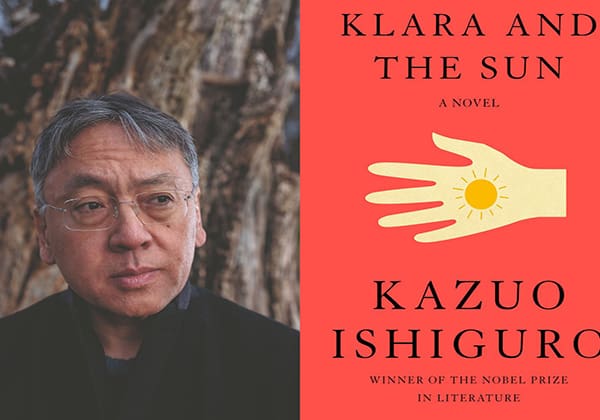This article is part of Honi’s coverage of the Sydney Writers’ Festival.
For the twentieth-century psychoanalyst Jacques Lacan, aesthetics is necessarily constituted by a central hollowness, an unspeakable void; ‘all art,’ he claims, ‘is characterised by a certain mode of organisation around this emptiness’. Klara and the Sun, the latest novel by Kazuo Ishiguro, and his first since winning the Nobel Prize, seems to support Lacan’s thesis. It is a novel concerned with lack – with knowing and not-knowing. This primary dilemma is not only articulated thematically, but ultimately involves a problem of narrative epistemology, because Ishiguro’s project is to dissect and anatomise the vagaries of the heart from the perspective of a narrator, a character who cannot understand them at all because she is a machine.
Klara is an ‘Artificial Friend,’ designed to provide companionship to children in a vaguely grim near-future neoliberal hellscape. Teenagers are taught at home by their ‘screen professors’, parents host ‘interaction meetings’ to acclimatise their lonely children to normal social interaction, and the adults bat around terms like ‘post-employed’ with frightening ease. Those who can afford it have their children ‘lifted’ – enhanced by genetic editing – but this is a dangerous procedure which leaves some recipients, like Josie, grievously ill. Thus, when Josie and her mother walk for the first time past the shop window where Klara spends her days on display, Ishiguro sets in motion an unstoppable boulder of a narrative, gathering emotional heft until it rolls, suddenly, over the cliff edge into the void, and a dreadful possibility is disclosed.
Ishiguro’s prose is characteristically bloodless and transparent, and it aptly conveys both Klara’s impeccably mannered dialogue and the naïve, wide-eyed quality of her observations. Klara is at once highly perspicacious and yet totally innocent of the ways of the world; her narration is affecting precisely because it is so unaffected and unadorned. One day, when a pair of old friends recognise each other across the street outside, Klara watches one of them ‘raise a fist to one of his eyes, in the way I’d seen some children do in the store when they got upset.’ When the long-separated pair finally embrace, ‘holding each other so tightly they were like one large person,’ Klara observes to her manager that ‘they seem so happy … But it’s strange because they also seem upset.’ Even after Josie picks her out at the store and she is taken home, Klara spends much of her time observing others, for, as she explains, ‘the more I observe, the more feelings become available to me.’ Josie’s mother’s response is swift and cynical: ‘In that case, maybe you shouldn’t be so keen to observe.’ Here is illustrated a pattern which recurs throughout the novel in manifold variations: Klara, who wishes to understand the heart, but can’t, is hopelessly at cross purposes with the adult humans around her, who could understand, but don’t want to.
The limits of Klara’s vision are not only mental but also quite physical, and the close correspondence between these two modes of knowledge in the novel deepens its sensitive rendering of her predicament. Her artificial vision is partitioned into a mosaic of boxes, which sometimes become skewed and distorted, splintered into a matrix of contradictory perceptions which she cannot reconcile. Klara is eternally poised in the gulf between perception and understanding – a gulf over which she cannot leap, however hard she may try.
Klara’s innocence is figured most powerfully in two sequences where she participates in a hallucinatory communion with the Sun, having convinced herself, because she herself is solar-powered, that he is a benevolent deity who may be persuaded into helping the ailing Josie. There is a happy resolution to her quest to recruit the Sun’s ‘special help’, and the ending towards which the plot seems to have been slouching is averted. But herein lies one of the novel’s weaknesses. No longer building up to a crescendo of immense and awful possibility, the tempo dissipates, and Ishiguro’s crisp prose begins to thicken into watery oatmeal. His signature narratorial techniques of temporal translocation and retrospection start to feel awkwardly conscious of themselves, and the end of the novel is peppered with dialogue so aimless and clichéd that it borders on the truly perverse.
Notwithstanding these blemishes, however, once the main plot is resolved, our attention is turned to a question we may not previously have considered. What happens to Klara, Josie’s childhood companion, when Josie is all grown up? When the answer is revealed in the last few pages, Ishiguro, the master of pathos without sentiment, is in full form. Klara is content with her new fate, blissfully unaware of the contortions of the human heart that have landed her there – but the audience is all too aware, and understands all too well.





